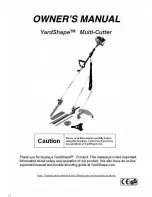
g346321
Figure 31
1.
Top locknut
5.
Belt cover
2.
Left side
6.
Nuts
3.
V-belts
7.
Pivot bolt
4.
Locknut under the plate
8.
Bolt in slot
Adjusting the Conveyor
Belt Alignment
If the conveyor belt starts slipping or moving sideways
after use or after new installation, adjust the conveyor
belt tension.
1.
Check if the rollers and the inside of the
conveyor belt are clean. If necessary clean the
rollers and remove any dirt inside.
2.
Release the tension of the conveyor belt by
loosening the left and right screws.
3.
Mark both sides of the belt with 2 measurement
marks a distance of 1000 mm (39-13/32 inch)
apart; refer to
.
g346659
Figure 32
1.
Lower screw
3.
Upper left screw
2.
Upper right screw
4.
Adjust the screws on both sides evenly till the
distance between the marks has increased to an
initial dimension of 1004 mm (39-1/2 inch).
Note:
Make the adjustments evenly on both
sides in small steps.
5.
Run the conveyor belt only slowly to detect any
belt movement and before any damage occurs.
6.
If the belt keeps slipping, adjust the screws
evenly till a maximum of 1010 mm (39-13/16
inch).
7.
If the conveyor belt tends to move to the left, give
a little more tension on the lower left adjustment.
If the conveyor belt moves to the right, give a
little more tension to the lower right adjustment.
Note:
Carry out the adjustments in small steps.
Belt Tensioning
Belt movement
The belt moves to
the left.
The belt moves to
the right.
Adjustment
Tighten the lower
left screw.
Tighten the lower
right screw.
23










































